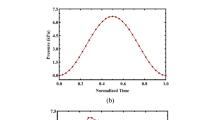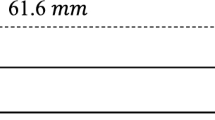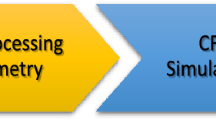Summary
The mechanisms for development of collaterals following a gradual occlusion (Ameroid technique) of one the coronary arteries in the dog were investigated. A control systems approach, based on quantitative experimental data, was utilized. The peripheral coronary pressure, peripheral coronary flow, coronary reserve flow, collateral resistance, peripheral coronary resistance, oxygen availability and demand were among the parameters studied. These variables were followed through the preocclusion phase, occlusion phase, ischemic phase, and post-ischemic phase of a gradual coronary constriction. The simulation studies were examined for the following basic assumptions: 1) ischemia is the sole stimulus for collateral development, 2) the peripheral coronary vasculature exhibits autoregulation and the peripheral coronary resistance increases during ischemia, 3) autoregulation occurs but during ischemia the peripheral vasculature remains maximally dilated without increase in resistance, and 4) the peripheral coronary vasculature is non-autoregulatory. It was concluded that neither ischemia nor a pressure differential can solely account for collateral development It is believed that ischemia begins the collateral growth process and it is sustained by the pressure differential (or some manifestation thereof) during the post-ischemic phase. Assumption 2 is most consistent with both physiological and clinical data. The autoregulatory capacity of the peripheral coronary bed allows a constriction of 76% before the resting coronary flow is impaired.
Zusammenfassung
Die Mechanismen, die nach einer fortschreitenden Koronarokklusion (Ameroid-Methode) zur Kollateralentwicklung führen, wurden an Hunden untersucht. Mit Hilfe der Regelungstheorie und quantitativer experimenteller Daten wurde das Koronarsystem analysiert. Unter anderen Varianten wurden der periphere Koronardruck, die periphere Koronardurchblutung, Koronarreserve, Kollateralwiderstand, der periphere Koronarwiderstand, Sauerstoffverfügbarkeit und-verbrauch in Betracht gezogen. In dieser Analyse wurden die folgenden Möglichkeiten in Betracht genommen: 1. ob Ischämie der einzige Reiz zur Kollateralenbildung sein könnte; 2. die peripheren Koronargefäße autoregulieren und der periphere Koronarwiderstand während Ischämie steigt; 3. Autoregulation besteht, der periphere Widerstand sinkt auf ein Minimum ab, aber steigt nicht wieder unter dem Einfluß der Ischämie; 4. der periphere Widerstand bleibt konstant. Die Resultate erwiesen, daß weder Ischämie allein noch ein Druckgefälle allein für die Kollateralenbildung verantwortlich sein können. Die Hypothese, daß Ischämie das Kollateralenwachstum veranlaßt, dieses Wachstum aber von hämodynamischen Faktoren weiter erhalten wird, wurde vorgelegt.
Similar content being viewed by others
References
Altman, P. L., andD. S. Ditmer (editors) Biological Tables, Section: Metabolism (Bethesda, Md. Fed. Am. Soc. Exptl. Biology 1968).
Anrep, G. V., andH. Häusler, The coronary circulation. I. The effect of changes of the blood pressure and of the output of the heart. J. Physiol.65, 357–373 (1928).
Baghirzade, M. F., U. Kirsch, andU. Hauschild, Capillareinengung bei anoxisch und ischämisch bedingtem Anstieg des Coronarwiderstandes im Meerschweinchenherzen. Virchows Arch. Abt. A Path. Anat.351, 193–204 (1970).
Berne, R. M., andR. Rubio, Acute coronary occlusion: Early changes that induce coronary dilatation and the development of collateral circulation. Amer. J. Cardial.24, 776–781 (1969).
Bester, A. J., E. Bajusz, andA., Lochner, Effect of ischemia and infarction on the metabolism and function of the isolated, perfused rabbit heart. Cardiovasc. Res.6, 284–294 (1972).
Blomqvist, C. G., Use of exercise testing for diagnostic and functional evaluation of patients with arteriosclerotic heart disease. Circulation44, 1120–1136 (1971).
Connor, J. T., K. W. Scheel, andP. H. Lehan, Flow resistance in catheters used in biological experiments. J. Miss. Acad. Sci.15, 13–16 (1965).
Conrad, M. C., J. L. Anderson, III, andJ. B. Garrett, Jr., Chronic collateral growth after femoral artery occlusion in the dog. J. Appl. Physiol.31, 550–555 (1971).
DeBrabander, M., andW. Schaper, Quantitative histology of the canine coronary collateral circulation in localized myocardial ischemia. Life Sci.10, 857–868 (1971).
Eckstein, R. W., Development of interarterial coronary anastomoses by chronic anemia. Disappearance following correction of anemia. Circ. Res.3, 306–310 (1955).
Eckstein, R. W., The ineffectiveness of cortisone on functional coronary interarterial anastomoses. Circ. Res.2, 466–470 (1954).
Elliot, E. C., C. M. Bloor, E. L. Jones, W. J. Mitchell, andD. E. Gregg, Effect of controlled coronary occlusion on collateral circulation in conscious dogs. Amer. J. Physiol.220, 857–861 (1971).
Elliot, E. C., E. L. Jones, C. M. Bloor, A. S. Leon, andD. E. Gregg, Day-to-day changes in coronary hemodynamics secondary to constriction of circumflex branch of left coronary artery in conscious dogs. Circ. Res.22, 237–250 (1968).
Garamella, J. J., V. P. George, Jr., and,L. J. Hay, A correlative study of peripheral coronary pressures and coronary arteriography following coronary occlusion. Surg., Gynecol., Obstet.105, 89 (1957).
Gensini, G. G., andB. C. B. Da Costa, The coronary collateral circulation in living man. Amer. J. Cardiol.24, 393–400 (1969).
Gregg, D. E., Coronary Circulation in Health and Disease, p. 198 (Philadelphia 1950).
Gregg, E. D., J. J. Thornton, andF. R. Mautz, The magnitude, adequacy and source of the collateral blood flow and pressure in chronically occluded coronary arteries. Amer. J. Physiol.127, 161–175 (1939).
Guyton, A. C., J. M. Ross, O. Carrier, andJ. R. Walker, Evidence for tissue oxygen demand as the major factor causing autoregulation. Circ. Res.15, I-60–I-69 (1964).
Haddy, F. J., andJ. B. Scott, Metabolically linked vasoactive chemicals in local regulation of blood flow. Physiol. Rev.48, 688–707 (1968).
Haft, J. I., andA. N. Damato, Measurement of collateral blood flow after myocardial infarction in the closed-chest dog. Amer. Heart J.77, 641–648 (1962).
James, T. N., The delivery and distribution of coronary collateral circulation. Chest Dis.58, 183–203 (1970).
Jorgensen, C. R., K. Kitamura, F. L. Gobel, H. L. Taylor, andY. Wang, Long-term precision of the N2O method for coronary flow during heavy upright exercise. J. Appl. Physiol.30, 338–344 (1971).
Kaplinsky, E., W. B. Hood, Jr., B. McCarthy, H. L. McCombs, andB. Lown, Effects of physical training in dogs with coronary artery ligation. Circulation37, 556–565 (1968).
Khouri, E. M., D. E. Gregg, andG. M. McGranaham Jr., Regression and reappearance of coronary collaterals. Amer. J. Physiol.220, 655–661 (1971).
Knoebel, S. B., P. L. McHenry, J. F. Phillips, andF. J. Pauletto, Coronary collateral circulation and myocardial blood flow reserve. Circulation46, 84–94 (1972).
Kong, Y., J. T. T. Clen, H. J. Zeft, R. E. Whalen, andH. D. McIntosh, Natural history of experimental coronary occlusion in pigs: A serial cineangiographic study. Amer. Heart J.77, 45–54 (1969).
Liebow, A. S., Situations which lead to changes in vascular pattern. In: Handbook of Physiology, sect. 2, vol. II, p. 1251 (Washington, D. C., 1963).
Litvak, J., L. E. Siderides, andA. M. Vineberg, The experimental production of coronary artery insufficiency and occlusion. Amer. Heart J.53, 505–518 (1957).
Malinin, T. E., J. R. Stokes, J. B. Hardy, andG. Lumb, Experimental coronary artery narrowing in swine. Johns Hopkins Med. Soc.122, 102–111 (1968).
Mellander, S., andB. Johansson, Control of resistance, exchange and capacitance functions in the peripheral circulation. Pharmacol. Rev.20, 117–196 (1968).
Rakusan, K., Oxygen in the Heart Muscle, p. 25 (Springfield, Ill., 1971).
Rosenthal, S. L., andA. C. Guyton, Hemodynamics of collateral vasodilation following femoral artery occlusion an anesthetized dogs. Circ. Res.23, 239–248 (1968).
Schaper, W., M. DeBrabander, andP. Lewi, DNA synthesis and mitoses in coronary collateral vessels of the dog. Circ. Res.28, 671–679 (1971).
Schaper, W., The Collateral Circulation of the Heart.D. A. K. Black (editor), p. 21, 170, 51 (Amsterdam, London, New York 1971).
Schaper, W., Tangential wall stress as a molding force in the development of collateral vessels in the canine heart. Experientia23, 595–596 (1967).
Scheel, K. W., M. Banet, C. Ott, andP. H. Lehan, A quantitative approach to collateral and antegrade flow after coronary occlusion. Amer. J. Physiol.222, 687–694 (1972).
Scheel, K. W., The inaccuracy of the retrograde flow and peripheral coronary pressure methods in determining collateral flow. Proc., 24th Conf on Engr. in Med. and Biol.13, 123 (1971).
Schoop, W., andW. Jahn, Entwicklungsstadien arterieller kollateralen und ihre begriffliche Definition. Z. Kreislaufforschg.50, 249–254 (1961).
Sias, F. R., Jr., andT. G. Coleman, Digital simulation of biological systems using conversational languages. Simulation16, 102–111 (1971).
Thoma, R., Untersuchungen über die Histogenese und Histomechanik des Gefäßsystems (Stuttgart 1893).
Windblad, J. N., K. Reemtsma, J. L. Vernhet, L. P. Laville, andO. Creech, Jr., Etiologic mechanisms in the development of collateral circulation. Surgery54, 105–117 (1959).
Author information
Authors and Affiliations
Additional information
With 13 figures and 2 tables
This work was supported by grants HL-15 623, HL-09 495, HL-01 362, HL-14 032 of the National Institutes of Health, U.S. Public Health Service, and the Memphis and Tennessee Heart Association.
Rights and permissions
About this article
Cite this article
Scheel, K.W., Granger, H.J., Brody, D.A. et al. Mechanisms of collateral development and hemodynamics of gradual coronary occlusion. Basic Res Cardiol 69, 338–360 (1974). https://doi.org/10.1007/BF01905940
Received:
Published:
Issue Date:
DOI: https://doi.org/10.1007/BF01905940




